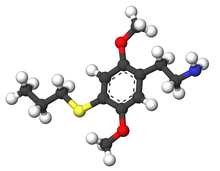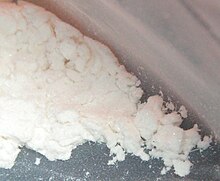
| |

| |

| |
| Names | |
|---|---|
| Preferred IUPAC name
2-[2,5-Dimethoxy-4-(propylsulfanyl)phenyl]ethan-1-amine | |
| Other names
2,5-Dimethoxy-4-(propylsulfanyl)phenethylamine, 2,5-Dimethoxy-4-(propylthio)phenethylamine, Blue Mystic, Tweety-Bird Mescaline
| |
| Identifiers | |
3D model (JSmol)
|
|
| ChEMBL | |
| ChemSpider | |
| KEGG | |
PubChem CID
|
|
| UNII | |
CompTox Dashboard (EPA)
|
|
| |
| |
| Properties | |
| C13H21NO2S | |
| Molar mass | 255.38 g/mol |
| Melting point | 206 to 207 °C (403 to 405 °F; 479 to 480 K) |
| Pharmacology | |
| Legal status |
|
Except where otherwise noted, data are given for materials in their standard state (at 25 °C [77 °F], 100 kPa).
| |
2C-T-7 is a psychedelic phenethylamine of the 2C family. In his book PiHKAL: A Chemical Love Story, Alexander Shulgin lists the dosage range as 10–30 mg. 2C-T-7 is generally taken orally, and produces psychedelic and entactogenic effects that last 8 to 15 hours.[1] Up until Operation Web Tryp and three deaths, two of which involved the use of other drugs in addition to 2C-T-7, and one which involved an excessive insufflated dose, 2C-T-7 was sold commercially in Dutch and Japanese smartshops and online. It is known on the streets as Blue Mystic or 7th Heaven.[2][3] There has been little real research done on this chemical other than Shulgin's comments in PiHKAL and a few small animal studies mostly aimed at detecting metabolites.
- ^ Shulgin A. "PIHKAL #43".
- ^ Platoni K (May 1, 2002). "2C-T-7's Bad Trip". East Bay Express.
In 1999 it made its first commercial appearance in the Netherlands' drug-dealing smart shops in both tablet and powder form. It was given the street name "Blue Mystic," perhaps in order to differentiate it from its chemical cousin, another Shulgin creation named 2C-T-2
- ^ O'Connell C (August 19, 2002). "A psychedelic summer". Newsweek.